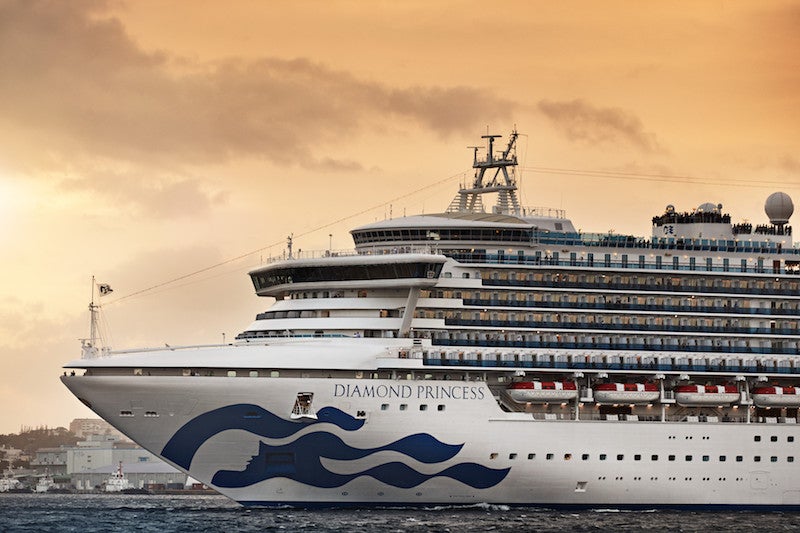
COVID-19 on the Diamond Princess Cruise Ship
On 5 February, the British flagged Princess Cruise’s Diamond Princess cruise ship made the headlines as most passengers and crew members were quarantined after an 80-year-old passenger tested positive for Covid-19.
The ship which had visited Hong Kong, Vietnam and Taiwan, was moored on 4 February, after its return to Yokohama, a city 30km south of Tokyo.
In July, researchers from Tokyo’s National Institute of Infectious Diseases published a study on what happened aboard the Diamond Princess and how the disease spread among passenger and crew members.
Evidence showed that the virus was disseminated through mass gatherings of people in recreational areas, with a peak backtracked to the period between 2 and 4 February.
Here is a timeline of what happened and the research that followed.
23–25 January
On 23 January, an 80-year-old man, who embarked on 20 January in Yokohama, started to present coughing symptoms. Two days later he disembarked in Hong Kong and visited a hospital while the Diamond Princess carried on its scheduled journey to Vietnam, Taiwan and Japan.
How well do you really know your competitors?
Access the most comprehensive Company Profiles on the market, powered by GlobalData. Save hours of research. Gain competitive edge.

Thank you!
Your download email will arrive shortly
Not ready to buy yet? Download a free sample
We are confident about the unique quality of our Company Profiles. However, we want you to make the most beneficial decision for your business, so we offer a free sample that you can download by submitting the below form
By GlobalData1 February
Princess Cruises, the ship’s owner, confirmed on 1 February that the passenger had tested positive for Covid-19. Authorities said that the man had not visited the ship’s medical facility and that, although still in hospital, his conditions remained stable.
3—4 February
After the announcement, quarantine officers started testing passengers and crew members, collecting upper-respiratory specimens from those exhibiting Covid-19 related symptoms.
The ship was scheduled to return on 4 February, but on the same day Princess Cruises announced a 24-hour delay of its turnaround to allow the Japanese health authorities to review the health status of both passengers and crew members.
5 February
On 5 February, there were 3,711 between passengers and crew aboard the Diamond Princess. The Japanese Government asked 3,600 of them to quarantine for 14 days, until 19 February.
9 – 18 February
In the space of these nine days before passengers were allowed to disembark, Princess Cruises reported an increase in the number of cases.
19 February
On 19 February, Princess Cruises confirmed that several embassies – including Canada and Hong Kong – had started to repatriate its citizens, requiring of them to self-isolate for 14 days upon arrival in their country of origin.
Japanese authorities added that the process was going to take a few days, as passengers needed to be tested first.
20 February
By 20 February, 600 passengers were allowed to disembark, after testing negative for Covid-19.
27 February
The disembarkation process for guests took eight days and it was over by 27 February, while 500 crew members remained on board, either waiting for government flights or to be transferred to a quarantine facility in Japan.
8 March
By 8 March, researchers from Tokyo’s National Institute of Infectious Diseases estimated that the total number of cases was 697 while seven people, all passengers, had died. In the end, more than 700 people were infected and 14 died.
What have researchers found?
Given its special status, the Diamond Princess in the past few months has become the subject of several studies on the spread of coronavirus.
By analysing haplotypes, the genetic determinants on single chromosomes, Japanese researchers from Tokyo’s National Institute of Infectious Diseases pinpointed how the virus spread, understanding that it was circulating aboard way before the quarantine was put in place.
“Superspreading occurred immediately after introduction of the virus, well before the quarantine started on February 3, 2020,” read the paper.
What also emerged is that the transmission was carried out through hidden links, including actions such as eating at the same dinner table.
Another possible way of spreading, scientists explained, was direct transmission as a result of cabin sharing. According to the data, three people who shared the same cabin during the quarantine had viruses with the same haplotype.
According to the study, the were no geographical clusters aboard the Diamond Princess, as people with symptoms were found all across the ship’s 18 decks.
“This may indicate that most SARS-CoV-2 infections began at mass-gathering events in the recreational areas, where all passengers enjoyed dancing, singing, shopping, and watching performances,” the paper continued.
Another paper, published in April, suggested that – despite the fact that the measures put in place prevented more than 2,000 cases – evacuating all passengers and crew members would have stopped the spread of the virus.
As for the mode of transmission, a joint report from Harvard’s School of Public Health and the Illinois Institute of Technology showed close-range aerosol transmission was the dominant mode after the quarantine began.
“Our results demonstrate that aerosol inhalation was likely the dominant contributor to Covid-19 transmission among passengers aboard the Diamond Princess Cruise Ship.”






